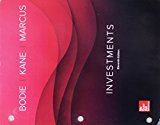
(A)
To Compute:
If the desired put option were traded. How much would it cost to purchase?
Introduction:
The value of put option is calculated using the formula given below.
Explanation of Solution
a) Computation of value of put:
Here, the investor would hold a put position. The current price is $100. This price could either
increase or decrease by 10%
Factor by which stock increases is u
Factor by which stock decreases is d
Calculation of option value
The two possible stock prices are
since, the exercise price is $100, and the corresponding two possible put values are
Calculation of the hedge ratio (H)
The hedge ratio can be calculated by using the following formula:
Here,
The value of the call option in case of in-the-money scenario is
The value of the call option in case of out-of-the-money scenario is
Factor by which stock increases u.
Factor by which stock decreases is d.
Stock price in case stock price increases is
Stock price in case stock price decreases is
Substitute:
Hence, the hedge ratio is -.5
The portfolio combining of two puts and one share brings an assured payoff $ 110 making it a riskless portfolio.
Calculation of the present value of certain stock price of $110 with a one-year interest rate of 5%:
Hence, the present value of certain stock price of $110 with a one-year interest rate of 5% $104.76
Comparing the protective put strategy and present value of stock we get,
One stock and two put options
Solve for the value of put (P):
Hence, the value of put option is $2.38.
Hence, the value of put option is $2.38.
(B)
To Compute:
What would have been the cost of the protective put portfolio? Introduction: The cost of protective put portfolio that comes out is calculated based on the given formula below.
Explanation of Solution
(b) Computation of cost of protective put portfolio:
The cost of the protective put portfolio is the cost of one share plus the cost of one put. It
can be calculated by using the following formula:
Hence, the cost of protective put portfolio comes out to be $102.38.
Hence, the cost of protective put portfolio comes out to be $102.38.
(C)
To Compute:
What portfolio position in stock and T-bills ill ensure you a payoff equal to the payoff that would be provided by a protective put with X-$100? Show that the payoff to this portfolio and
the cost of establishing the portfolio match those of the desired protective put.
Introduction:
The strategy is calculated in the table to determine the pay-off using the below calculation.
Explanation of Solution
To ensure equal pay-off in stock and T-bills and protective put is as follows
The hedge ratio is 0.50. The investor will invest 0.50 in stocks which costs $50 and
remaining in T-bills to earn 5% interest.

The above strategy will give same pay-off as the protective put option.
The above strategy will give same pay-off as the protective put option.
Want to see more full solutions like this?
Chapter 21 Solutions
GEN COMBO LOOSELEAF INVESTMENTS; CONNECT ACCESS CARD
- You are called in as a financial analyst to appraise the bonds of Ollie’s Walking Stick Stores. The $5,000 par value bonds have a quoted annual interest rate of 8 percent, which is paid semiannually. The yield to maturity on the bonds is 12 percent annual interest. There are 12 years to maturity. a. Compute the price of the bonds based on semiannual analysis. b. With 8 years to maturity, if yield to maturity goes down substantially to 6 percent, what will be the new price of the bonds?arrow_forwardLonnie is considering an investment in the Cat Food Industries. The $10,000 par value bonds have a quoted annual interest rate of 12 percent and the interest is paid semiannually. The yield to maturity on the bonds is 14 percent annual interest. There are seven years to maturity. Compute the price of the bonds based on semiannual analysis.arrow_forwardNeed solution this wuarrow_forward
 Intermediate Financial Management (MindTap Course...FinanceISBN:9781337395083Author:Eugene F. Brigham, Phillip R. DavesPublisher:Cengage Learning
Intermediate Financial Management (MindTap Course...FinanceISBN:9781337395083Author:Eugene F. Brigham, Phillip R. DavesPublisher:Cengage Learning
